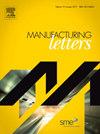Achieving uniform distribution of nanoparticles in oxide dispersion strengthened (ODS) SS316L through laser powder bed fusion (L-PBF)
IF 2
Q3 ENGINEERING, MANUFACTURING
引用次数: 0
Abstract
Oxide dispersion strengthened (ODS) SS316L is a promising candidate for the nuclear industry for its enhanced irradiation resistance and high temperature strength. Additionally, additive manufacturing enables the design flexibility of components. Achieving a uniform distribution of oxides in ODS SS316L is one of the remaining challenges in additive manufacturing. In this paper, we investigated the effects of printing parameters on the microstructure and mechanical properties of ODS SS316L (SS316L + 0.5 wt% Y2O3) through laser powder bed fusion (L-PBF) additive manufacturing. The results showed that plate-like Y-Si-rich oxides (∼50 μm) were observed along the molten pool boundary in the ODS SS316L printed with nominal parameters (48.5 J/mm3) for pure SS 316L, resulting from inadequate heat input in molten pool due to the reduced laser absorption rate of powder feedstock. Through higher volumetric energy density (76.2 J/mm3) and remelting, a bimodal distribution of oxides, including nanoparticles and fine spherical oxide (∼2.5 μm), was achieved. Consequently, this contributed to increased ultimate tensile strength (UTS) and strain of ODS SS316L from 685.2.6 ± 31.4 MPa and 27.8 ± 6.2 % to 706.6 ± 36.2 MPa and 33.0 ± 6.1 %, respectively. The exploration of parameters optimization provides valuable insights into the additive manufacturing of ODS alloys with uniformly distributed nanoparticles.
通过激光粉末床熔融 (L-PBF) 实现纳米粒子在氧化物分散强化 (ODS) SS316L 中的均匀分布
氧化物分散强化(ODS)SS316L 具有更强的耐辐照性和高温强度,是核工业的理想候选材料。此外,增材制造还能实现部件设计的灵活性。在 ODS SS316L 中实现氧化物的均匀分布是增材制造中仍然面临的挑战之一。本文通过激光粉末床熔融(L-PBF)快速成型技术,研究了打印参数对 ODS SS316L(SS316L + 0.5 wt% Y2O3)微观结构和机械性能的影响。结果表明,在以纯 SS 316L 的标称参数(48.5 J/mm3)打印的 ODS SS316L 中,沿熔池边界观察到富含 Y-Si 的板状氧化物(∼50 μm),这是由于粉末原料的激光吸收率降低导致熔池热量输入不足造成的。通过提高体积能量密度(76.2 J/mm3)和重熔,实现了氧化物的双峰分布,包括纳米颗粒和细球形氧化物(2.5 μm)。因此,ODS SS316L 的极限拉伸强度 (UTS) 和应变分别从 685.2.6 ± 31.4 MPa 和 27.8 ± 6.2 % 提高到 706.6 ± 36.2 MPa 和 33.0 ± 6.1 %。对参数优化的探索为均匀分布纳米粒子的 ODS 合金增材制造提供了宝贵的见解。
本文章由计算机程序翻译,如有差异,请以英文原文为准。
求助全文
约1分钟内获得全文
求助全文
来源期刊

Manufacturing Letters
Engineering-Industrial and Manufacturing Engineering
CiteScore
4.20
自引率
5.10%
发文量
192
审稿时长
60 days
 求助内容:
求助内容: 应助结果提醒方式:
应助结果提醒方式:


